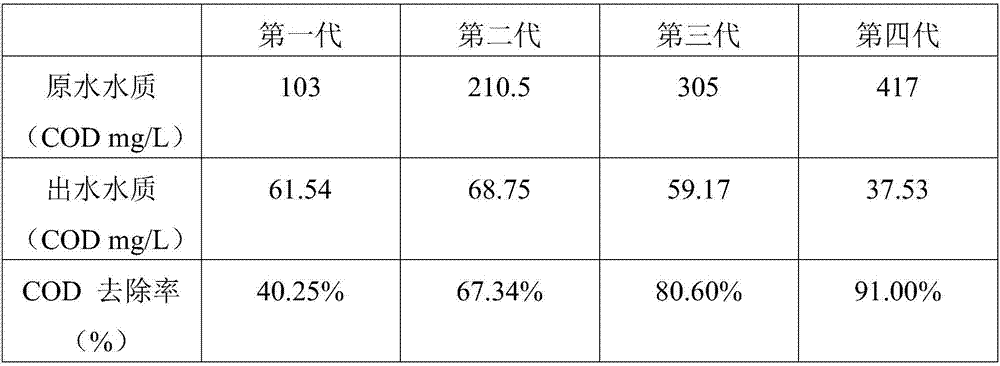Culture method for chlorella pyrenoidosa
A technology of Chlorella pyrenoidosa and a culture method, applied in the field of algae culture, can solve the problems of unfavorable large-scale culture, low oil content, low biomass and the like, and achieve the effects of promoting rapid proliferation, increasing oil content and high cell density
- Summary
- Abstract
- Description
- Claims
- Application Information
AI Technical Summary
Problems solved by technology
Method used
Image
Examples
Embodiment 1
[0021] Example 1: Screening and community structure identification of Chlorella pyrenoidosa and mixed flora symbiotic system
[0022] The water samples extracted from the biochemical pool activated sludge of the Harbin Municipal Sewage Plant were put into sterile sampling bags and brought back to the laboratory. Microscopic observation found that there were many microorganisms and algae cells in the samples, and the corresponding microalgae and microalgae associated flora were tested. Enrichment, separation and screening. Put the raw water samples into the simulated biochemical pool reactor for continuous cultivation, place the reactor under natural light, mix with the pre-prepared simulated urban sewage, and aerate for a long time to keep the oxygen content at 6-8mg / L , cultured at 32°C, pH 7.5 COD maintained at about 400mg / L, TN at about 50mg / L, and TP at about 10mg / L. The simulated urban sewage is simulated by the improved BG11 medium, and its simulated sewage composition ...
Embodiment 2
[0028] Example 2: Compound flora and activity verification
[0029] Simulate the composition ratio of the photosynthetic bacterial microbial community Rhodobacter sp. and Rhodopseudomonas sp. in Example 1, and compound it with Chlorella pyrenoidosa. Among them, the specific species of Rhodobacter sp. is Rhodobacter capsulatus, and the specific species of Rhodopseudomonas sp. is Rhodopseudomonas palustris. Among them, the single bacteria (algae) are respectively activated with LB medium, and the cell concentration is adjusted after activation, while the added concentration of Chlorella pyrenoidosa is two orders of magnitude greater than the concentration of the two kinds of photosynthetic bacteria. The oil content detection method was described, and the effect of the compound flora on the oil content of Chlorella pyrenoidosa was analyzed. After the cultivation, the oil content of Chlorella pyrenoidosa was 35.43%, and the growth was stable, and the algae cell density reached 5×...
Embodiment 3
[0030] Example 3: Optimization of growth and oil content of Chlorella pyrenoidosa with different medium concentrations and bacterial flora concentrations
[0031] Use sterile water to configure the optimized medium of Chlorella pyrenoidosa with the following formula: peptone 300mg / L, KH 2 PO 4 16mg / L, MgSO 4 ·7H 2 O 60mg / L, CaCl 2 2H 2 O 30mg / L, ferric ammonium citrate 8mg / L, NaHCO 3 10mg / L, trace element solution 0.5ml / L; also includes auxin indole acetic acid 1.0mg / L and vitamin B 2 Solution 0.5mg / L. 10 mL of mixed flora fermentation liquid including Rhodobacter capsulatus and Rhodopseudomonas palustris, in which the inoculation ratio of the two strains is 1:1. The specific composition of its mixed flora fermentation liquid is as follows: NH 4 Cl1g / L, K 2 HPO 4 0.5g / L, MgCl 2 0.2g / L, yeast powder 0.5g / L, sodium acetate 4g / L. The fermentation temperature is 30°C, 24 hours of continuous light, the intensity is 10000Lux, the fermentation time is 3 days, the inocu...
PUM
 Login to View More
Login to View More Abstract
Description
Claims
Application Information
 Login to View More
Login to View More - R&D Engineer
- R&D Manager
- IP Professional
- Industry Leading Data Capabilities
- Powerful AI technology
- Patent DNA Extraction
Browse by: Latest US Patents, China's latest patents, Technical Efficacy Thesaurus, Application Domain, Technology Topic, Popular Technical Reports.
© 2024 PatSnap. All rights reserved.Legal|Privacy policy|Modern Slavery Act Transparency Statement|Sitemap|About US| Contact US: help@patsnap.com










